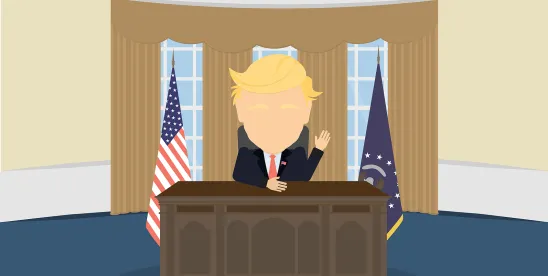For decades, businesses have focused on “doing more with less,” maximizing efficiency by optimizing resources and streamlining processes to achieve greater output with fewer inputs. This effort often involves leveraging technology, improving productivity, and reducing waste to maintain or enhance performance.
The second Trump Administration will likely be remembered for its Department of Government Efficiency (DOGE) initiative, which is working toward reorganizing federal agencies, canceling contracts, and reducing the government workforce. The Trump Administration is working on other regulatory reform efforts as well. Here, we break out various efforts the Administration has undertaken in furtherance of its deregulatory agenda.
Regulatory Background
The federal Administrative Procedure Act (APA) requires government agencies to follow certain procedures to adopt, amend, or repeal regulations. As we have discussed, the APA grants agencies the discretion to implement policy changes so long as they follow applicable procedural and substantive requirements. (For more see here.) Generally, the APA provides a structured process for creating regulations under which agencies draft proposed rules that are then published in the Federal Register to invite public comment by a set date. After reviewing feedback, agencies may revise the rules before finalizing them. The final rules are published, becoming legally binding unless challenged in court.
The Trump Administration argues that the certainty that historically flowed from the languid pace of regulations also generated inertia under which regulated entities suffered. Specifically, the Administration’s “Unleashing Prosperity Through Deregulation” order asserts that “[t]he ever-expanding morass of complicated Federal regulation imposes massive costs on the lives of millions of Americans, creates a substantial restraint on our economic growth and ability to build and innovate, and hampers our global competitiveness.”
Using standard procedures, repealing regulations often takes time. As one example, the APA provides that a regulation established using notice-and-comment procedures can be revised in most circumstances only by using the same procedures and even then, the revisions can be subject to litigation. Thus, eliminating regulations the Administration has targeted for repeal could take years. Accordingly, it is unsurprising that President Trump is attempting to use alternative means to accomplish his regulatory objectives.
Below, we explain four different procedures the Administration has indicated that it may deploy.
Deregulation After Request
The first method of deregulation may be the simplest; the Administration seeks to work with the regulated community to remove pressure points.
One way of doing this is through the typical government relations process in which businesses or trade associations seek meetings with government officials and share their concerns and ways the government might address them. Government relations attorneys (including ourselves) and colleagues can assist in framing requests to regulators and providing focused and appropriate information.
A second means involves technology. Shortly after taking office, regulations.gov was modified to include a page for “Deregulation suggestions.” The page — styled as a submission form — asks for regulatory background; an indication of what kind of regulatory recission is requested (e.g.,notice of proposed rulemaking, final rule, direct final rule, etc.); a justification as to why recission is required; and information on the involved agency. Direct outreach in this manner is one means to address regulated community concerns and to solicit deregulatory ideas.
Compelled Deregulation
The Administration might also compel agencies to winnow back regulations. Two concepts embraced by the Trump Administration illustrate this approach.
Ten-For-One: Executive Order (EO) 13771, signed in 2017 during President Trump’s first term, aimed to reduce regulation and control regulatory costs by requiring agencies to repeal at least two existing regulations for each new one issued, and by imposing a regulatory budget that capped the total incremental costs of new regulations. This “two-for-one” rule and regulatory budget were intended to encourage agencies to be more cost-conscious in their regulatory activities. In his second term, President Trump quintupled this requirement requiring that 10 rules be repealed for every new rule issued.
Zero-Based Budgeting: In the EO entitled “Zero-Based Regulatory Budgeting to Unleash American Energy,” the Administration requires agencies to reexamine regulations that may sit on the books unexamined for long periods of time. For agencies touching on energy and environmental issues (e.g., US Environmental Protection Agency, the US Army Corps of Engineers, and the US Department of Energy), agencies must promulgate a “sunset rule” rendering a wide swath of regulations invalid no more than five years in the future unless the director of the White House Office of Management and Budget determines that the regulation or amendment “has a net deregulatory effect.”
Automatic Deregulation
Another method the Administration appears willing to explore is deregulation after a demonstration (by whom?) that the regulation has been effectively superseded by intervening case law. In these circumstances, the APA’s “good cause” exemption may allow notice-and-comment procedures to be avoided in favor of using other tools like “interim final rules” or “direct final rules” to deregulate faster. (For more on this, see here.)
Amongst its suite of EOs and related memoranda released in early April, the Trump Administration released an order, “Directing the Repeal of Unlawful Regulations.” The order notes that several recent US Supreme Court decisions have limited the power of federal agencies, including Loper Bright Enterprises v. Raimondo (reducing deference given to agency interpretations of statutes), West Virginia v. EPA (preventing agencies from resolving “major” economic or political questions), and Sackett v. EPA (narrowing the definition of water bodies subject to federal Clean Water Act regulation), and suggests that agencies should take steps to “effectuate the repeal” of any identified “potentially unlawful regulations.” Where possible, these steps could include invoking the APA’s “good cause” exception on the grounds that notice and comment is “unnecessary” where the existing regulations are inconsistent with binding precedent. In practice, recent Trump Administration guidance related to the social cost of carbon builds on this approach by referring to a principle of “nonacquiescence,” which provides that lower court decisions that are inconsistent with agency preferences can be viewed as nonbinding. (For more see here.) If the executive branch is permitted to limit the effects of non-Supreme Court decisions on federal regulations, the need for formal deregulation may be minimized.
Deregulation by Algorithm
Finally, a recent Wired article noted that a DOGE operative, who most recently had been a third-year student at the University of Chicago, has been tasked with using artificial intelligence to rewrite US Department of Housing and Urban Development (HUD) regulations. The article reports that the operative “appears to be leading an effort to leverage artificial intelligence to review HUD’s regulations, compare them to the laws on which they are based, and identify areas where rules can be relaxed or removed altogether.” This effort, purportedly, has resulted in an Excel spreadsheet with proposed changes that requires past regulations’ “overreach” to be reviewed by HUD staffers for submission to HUD’s Office of General Counsel for approval.
Preparing for Deregulation
The regulated community can best position itself for business impacts — positive or negative — flowing from deregulation by first conducting a holistic review of regulatory pressure points and then (with counsel and a strong government relations team) develop a plan to maximize benefits and minimize potential downside impacts through business, government affairs, and legal efforts. While some of the Administration efforts outlined above may be subject to challenges in litigation, it is also possible that US Congress could render permanent some deregulatory efforts through legislation.




 />i
/>i
